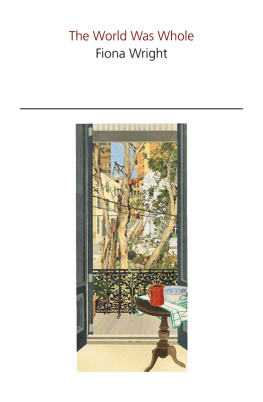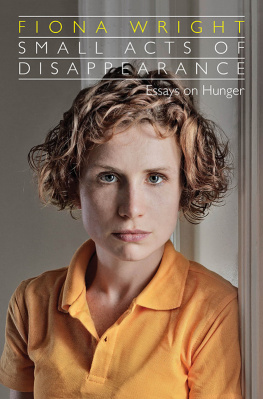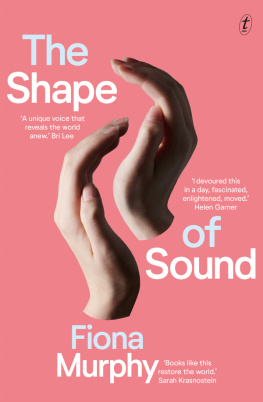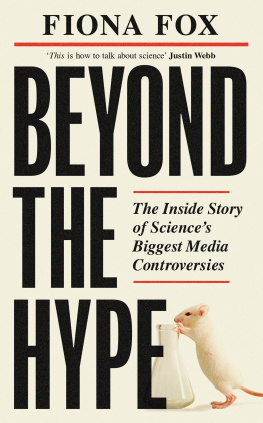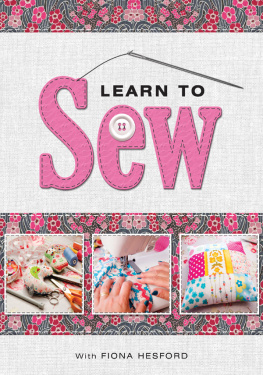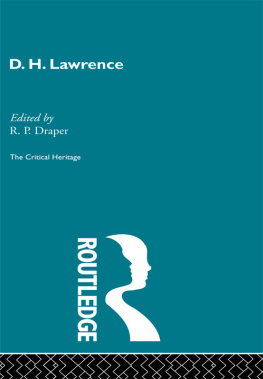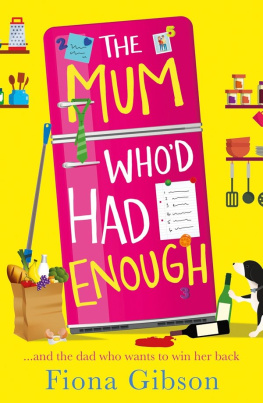Fiona Wright - The World Was Whole
Here you can read online Fiona Wright - The World Was Whole full text of the book (entire story) in english for free. Download pdf and epub, get meaning, cover and reviews about this ebook. year: 2018, genre: Non-fiction / History. Description of the work, (preface) as well as reviews are available. Best literature library LitArk.com created for fans of good reading and offers a wide selection of genres:
Romance novel
Science fiction
Adventure
Detective
Science
History
Home and family
Prose
Art
Politics
Computer
Non-fiction
Religion
Business
Children
Humor
Choose a favorite category and find really read worthwhile books. Enjoy immersion in the world of imagination, feel the emotions of the characters or learn something new for yourself, make an fascinating discovery.
- Book:The World Was Whole
- Author:
- Genre:
- Year:2018
- Rating:5 / 5
- Favourites:Add to favourites
- Your mark:
- 100
- 1
- 2
- 3
- 4
- 5
The World Was Whole: summary, description and annotation
We offer to read an annotation, description, summary or preface (depends on what the author of the book "The World Was Whole" wrote himself). If you haven't found the necessary information about the book — write in the comments, we will try to find it.
The World Was Whole — read online for free the complete book (whole text) full work
Below is the text of the book, divided by pages. System saving the place of the last page read, allows you to conveniently read the book "The World Was Whole" online for free, without having to search again every time where you left off. Put a bookmark, and you can go to the page where you finished reading at any time.
Font size:
Interval:
Bookmark:
THE WORLD WAS WHOLE
FIONA WRIGHT

The World Was Whole
FIRST PUBLISHED 2018
FROM THE WRITING AND SOCIETY RESEARCH CENTRE
AT WESTERN SYDNEY UNIVERSITY
BY THE GIRAMONDO PUBLISHING COMPANY
PO BOX 752
ARTARMONNSW 1570 AUSTRALIA
WWW.GIRAMONDOPUBLISHING.COM
FIONA WRIGHT 2018
DESIGNED BY HARRY WILLIAMSON
TYPESET BY ANDREW DAVIES
IN 12/17 PT GARAMOND 3
PRINTED AND BOUND BY LIGARE BOOK PRINTERS
DISTRIBUTED IN AUSTRALIA BY NEWSOUTH BOOKS
A CATALOGUE RECORD FOR THIS BOOK IS AVAILABLE
FROM THE NATIONAL LIBRARY OF AUSTRALIA .
ISBN: 978-1-925336-97-9
COVER IMAGE:
CRESSIDA CAMPBELL
FRANCIS STREET, EAST SYDNEY 2000
WOODBLOCK P R I N T, 1 1 5 5 1 C M
NATIONAL GALLERY OF AUSTRALIA, CANBERRA
PURCHASED 2000
CRESSIDA CAMPBELL
ALL RIGHTS RESERVED.
NO PART OF THIS PUBLICATION MAY BE REPRODUCED,
STORED IN ARETRIEVAL SYSTEM OR TRANSMITTED
IN ANY FORM OR BY ANY MEANS ELECTRONIC,
MECHANICAL, PHOTOCOPYING OR OTHERWISE WITHOUT
THE PRIOR PERMISSION OF THE PUBLISHER.
9 8 7 6 5 4 3 2 1
FOR ASHLEIGH, ZOEY AND MIA
ALSO BY FIONA WRIGHT
NON - FICTION
SMALL ACTS OF DISAPPEARANCE
POETRY
KNUCKLED
DOMESTIC INTERIOR
CONTENTS
TO RUN AWAY FROM HOME
F or years when I talked about the place where I grew up, when I talked about that first home thats supposed to be the most important of them all, I would talk about a deepest, darkest suburbia, about a one-road-out inaccessibility, a ninety-minute, two-trains-and-a-bus commute into the city, as if these things were important, as if these things were unusual, or aberrant, in a city like Sydney, so sprawling and unruly. When I talked about Menai, the place where I grew up, the story I would tell was one of flight, of leaving as soon as I was able (although in truth, I moved out only at the age of twenty-four), of finding my tribe, as if thats a process thats ever neat or complete. My parents built their house in 1980; it was the first on their street, which was named, like all of the streets around it, after a cricketer. I like to imagine them, ridiculously young, my father thickly moustached, my mothers head haloed in frizzy curls, standing in the dirt outside the back door, grinning and holding shovels. They look excited, and in love, both with each other and with their new, own corner of the world. My parents still live in that house, although its bigger now, and our childhood bedrooms have become the study, the sewing room, the grandkids room, respectively. When I stay there overnight, I always sleep deeply, darkly, long, it is so quiet and so unlit. And then I drive away.
It used to bother me, deeply, darkly and for far too long, that I didnt feel I fit there. I never did, but it was worst at the height of my illness, when my visits were fuelled by awkwardness and anxiety, so much so that I was barely present, even though I was physically there. Id drink too much and talk too fast and eat too little, always caught up in the demands and constant calculations of my disease. I didnt know what was happening. I blamed myself: it was me, after all, who didnt fit.
But what I came to realise, slowly, was that the place didnt fit me. This sounds like platitude, perhaps, but it was an important realisation: that our places and our built environments are precisely that they are built, they are designed and planned, theres nothing natural or inevitable about them. Theres nothing inevitable about our homes, about our cities, about the ways we move in and through them. We just forget to see this because we see our places everyday; and when we grow up within them, they shape our baseline expectations of the way things are, will always be.
I was still living at home that strange phrase that really means living in my parents house when I first became ill, with a rare and complicated stomach condition, that saw me throwing up, without volition, almost every time I ate, that altered, abruptly and completely, my ordinary world, that eventually developed into the disordered eating and anorexia that Ive spent years, since, trying to understand and overcome, through writing as well as through medical treatment. Illness is a state we do not think of as everyday, but it affects those of us it impresses itself upon every single day. Those baseline expectations I had to reset, and its hard, sometimes, not to long or grieve for my younger, healthy self, whose world was unruptured, who was still able to forget.
It was easy to forget, because I saw them every day, that the suburbs were invented. That even though the vast majority of this countrys population lives within the limits of cities like Sydney, these cities are new compared to the stolen land that they stand on, and their suburbs even newer. It is easy to forget, especially with our culture of historical amnesia, that the creation of these suburbs, at the turn of the last century, was a political act, and one designed to remedy the various ills that were believed to exist in crowded, inner-city terrace slums poverty, illness, crime, fomenting socialism. With their gardens, their provision of light, space and air, the suburbs were intended to improve the lifestyle, and the moral and political character, of their inhabitants. Suburban homeowners, it was thought, were unlikely to radicalise, to want to tear down a nation in which they were quite literally invested. But the foreseen improvements were also physical, almost eugenic the first chairman of the Australian Housing Board stated that children brought up in suburban conditions would grow up taller, stronger, deeper in the chest. A better human being with a better body was very much a part of the original suburban imaginary of a bigger space, cleaner air, private lawns. That this body was white went without saying.
That the body and the home are linked is nothing new, of course; its quite probably an inevitable consequence of the categorical distinction we still make between the body and the mind, where the physicality of the body, unthinking, untameable, animal, is important primarily because it is the thing that carries, or houses, our rational, remarkable minds it is the home, that is, for who we are. And yet, as Gaston Bachelard argues in The Poetics of Space, the places that we move through often, that we inhabit, also become inscribed upon the body as habits of movement: that instinctual grasping of a door handle in the dark, the collapse into a favourite chair where we know it will catch us, and at what height. And in return our bodies shape our homes, leaving their traces in shed hairs and skin cells, indents in mattresses, scratched floorboards and the stains left by spilled drinks.
The feeling I have when I visit my first home that originary suburb with its wide roads that pass my primary school, the playground where I scarred my knee, the shopping centre where I got my ears pierced is never quite one of congruence, although it still feels like it should be and I still wish that it would be. Because if we carry our homes within our bodies, as Bachelard suggests, just as we house our bodies in our homes, I dont know what this means for those of us whose bodies are contested. Whose bodies feel unnatural, uncomfortable. For those of us who cannot be at home, as it were, within our flesh.
A few years ago I was recruited Im not sure why to take part in a market-research focus group for a homewares company, held after hours in the over-designed Surry Hills offices of an agency tasked with re-working their brand. Theyd chosen only women; three groups of about a dozen each, most of whom owned their own homes. They told us we were making the future and showed us a brand story called aspirational living. The women in my group professed to love shopping for figurines, vases, cushions, candles, lamps, knick-knacks, throws, rugs, prints and kitchenware; they said that homewares give a house a sense of character and make it your place, that they like pretty things and rooms with warmth, and it wasnt hard to see that they were also talking about themselves, or, at least, their visions of themselves as theyd like to be seen. They stuck the words welcoming and belonging to an oversized post-it note on the wall, and one woman, with long hair and sinewy brown arms, added not clinical, not sterile. And I was thrown immediately back into my body, which I was still, so many years since I first sought treatment, dragging along to clinics twice a week, which still only menstruated sporadically, which still had so little cushioning or soft furnishing, as it were, which, by this reckoning, could not be a home.
Next pageFont size:
Interval:
Bookmark:
Similar books «The World Was Whole»
Look at similar books to The World Was Whole. We have selected literature similar in name and meaning in the hope of providing readers with more options to find new, interesting, not yet read works.
Discussion, reviews of the book The World Was Whole and just readers' own opinions. Leave your comments, write what you think about the work, its meaning or the main characters. Specify what exactly you liked and what you didn't like, and why you think so.

